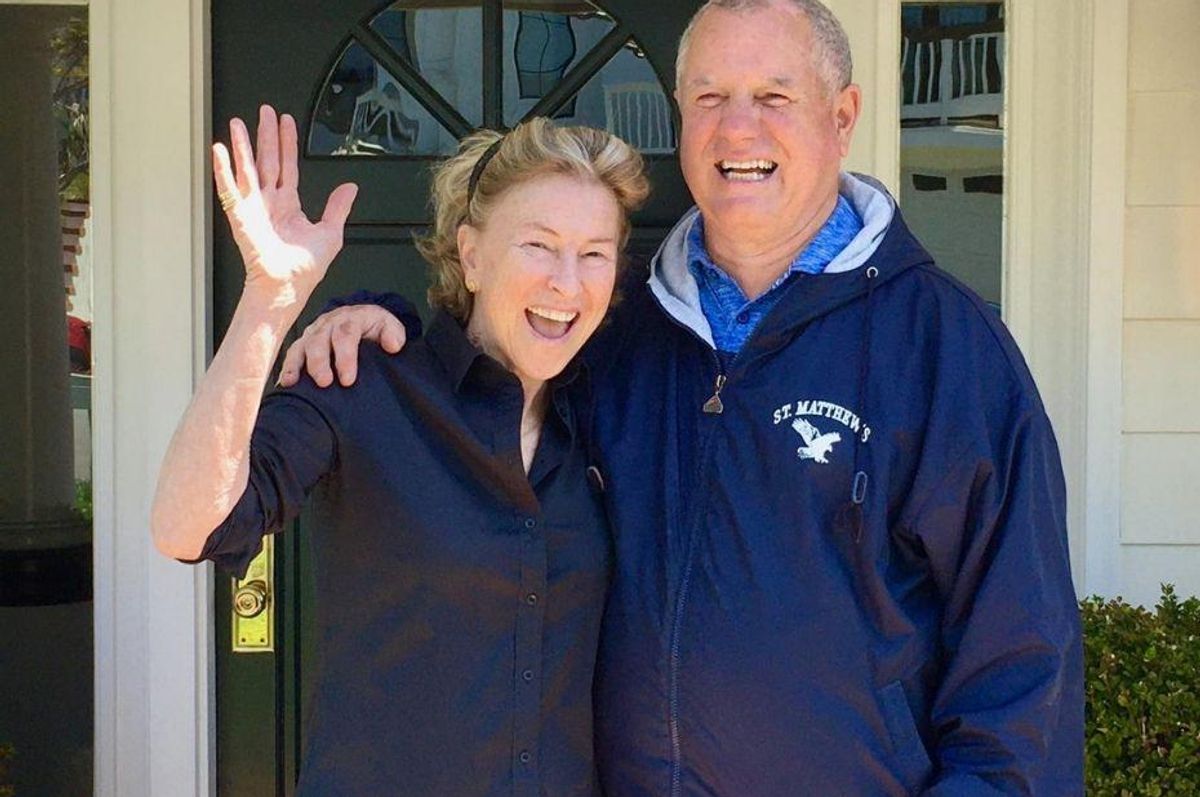Empty nesters share their genius—and surprisingly touching—secret to downsizing
"All I have to do is look in the eyes of my two girls—and they take me back, every time, to the most beautiful, colorful, emotional scrapbook I could ever dream of having."

Jimmy and Catherine Dunne figured out the secret to downsizing.
When your final child leaves the house for good, it's like a whole new world has opened up. The decades raising babies and children are full, rich, exciting and loud. Your house is filled with laughter and sibling bickering, school projects and kid collections, never-ending laundry and food purchased in bulk. Life is big during those years. It takes up space physically, mentally and emotionally.
Then come the empty nest years, when you find yourself swimming in a house full of unused rooms and piles of memories. Suddenly you don't need all that space anymore, and you have to figure out what to do with those rooms and those piles and those memories.
For one couple, the process of downsizing brought about a reflection on their family life, their relationship with their kids and their stuff. Jimmy Dunne shared that reflection on Facebook in a since deleted viral post that resonaed with many people who are at or near this stage in life.
 man and woman standing beside fence during daytimePhoto by Caspar Rae on Unsplash
man and woman standing beside fence during daytimePhoto by Caspar Rae on UnsplashDunne wrote:
"My wife Catherine and I recently moved.
I realized I had something I never knew I had.
Thirty-four years ago, I carried my wife in my arms over the threshold in our home. Thirty-four years ago. From newlywed days, to witnessing our babies go from little girls to young adults. So many great memories in every inch of every room of our home.
I didn’t think I was ready to ‘downsize.’ What an awful word. I liked walking through our girl’s bedrooms and still seeing their stuff on the walls and on the shelves. I liked our backyard. I liked imagining our kids coming down the steps every Christmas morning.
We put it on the market, it sold in a couple days, and suddenly agreements thicker than my leg were instructing me to clear everything I ever had and knew – out.
Every night I found myself saying goodbye to our backyard, to our garden of roses that Catherine would till and trim, to the sidewalk where the girls drove their Barbie cars and learned to ride their bikes, to our front lawn where we hosted tons of talent shows with all the kids on the block – and the red swing on the front porch.
We found a condo in town and started lining up our ducks of what we were keeping, and what we were tossing. We vowed, if we’re going to do this, we weren’t putting anything in storage.
I literally threw out half my stuff. Half. Half of the furniture. Half of my clothes, books. And the big one… way more than half the boxes in the attic.
The attic was more than an attic. It held our stories. Every thing in every box, every framed picture was a story. After we gave away almost all of the living room furniture, we split the room in half and brought down everything of the girls from the attic and from their rooms. We invited the girls over, handed them a cocktail and said, “There’s good news and bad news. We’ve saved all this stuff; your outfits, drawings, dolls, skates -- for you. It’s now yours. The bad news, whatever’s not gone by Friday at 10 in the morning, it’s getting chucked in that giant green dumpster in front of the house.”
The girls thought we were Mr. and Mrs. Satan. But they went through it, and that Friday, most of it went out the front door and right in the dumpster.
I filled the entire dining room with boxes of all my old stuff. Grade school stories and pictures, report cards, birthday cards, trophies, you name it. Boxes of old plaques and diplomas and just stuff and stuff and stuff like that. How could I throw any of this out? I may as well have been throwing me in the dumpster!
But this little jerk on my shoulder kept asking -- what are your kids going to do with all this a week after you're six feet under? They’re gonna chuck it all out!
Here’s the crazy thing. The more I threw stuff in there, the easier it got. And I started to kind of like throwing it up and over in that thing. I started to feel lighter. Better.
And we moved in a half-the-size condo – and the oddest thing happened.
It became our home.
A picture here and there on the wall, Catherine’s favorite pieces of furniture, all her knickknacks in the bathroom. We blinked, and it looked and felt just like us.
And then I found that thing I never knew I had.
Enough.
I had enough.
The wild thing was that having less – actually opened the door to so much more. More in my personal life. More in my career. More in everything.
All I have to do is look in the eyes of my two girls -- and they take me back, every time, to the most beautiful, colorful, emotional scrapbook I could ever dream of having.
All I have to do is hold my wife’s hand, and it hypnotizes me back to kissing her for the first time, falling in love with everything she did, seeing her in that hospital room holding our first baby for the first time.
It sure seems there is so much more to see, and feel, and be – if I have the courage, if I have the will to shape a life that’s just…
Enough."
 man kissing woman on check beside body of waterPhoto by Esther Ann on Unsplash
man kissing woman on check beside body of waterPhoto by Esther Ann on UnsplashPeople shared Dunne's post more than 24,000 times and it's easy to see why. He's speaking a truth we probably all know deep down on some level. Things don't make a life. Things don't make relationships. They don't even make memories, though we tend to hold onto them as if they do. We may associate places and things with memories, but we don't need the places and things for our memories to live on.
Kudos to Dunne and his wife for looking ahead to what their children would have to go through after they pass if they didn't go through it now themselves. And kudos to them for truly embracing the freedom that comes with having raised your children to adulthood. The empty nest years can be whatever you choose to make of them, and this couple has figured out a key to making the most of theirs.
This article originally appeared four years ago.
- One woman worked multiple jobs and downsized her lifestyle to live ... ›
- Michelle Obama opens up to Oprah about her new 'empty-nester' life ... ›
- This empty nesters' hilarious viral photo shoot has parents ... ›
- Woman sharing Costco employee card got a puzzling reaction - Upworthy ›
- Happiness expert shares blunt advice for empty nesters: Stop smothering your college aged kids - Upworthy ›






 Woman uses a steam cleaner on a rug.
Woman uses a steam cleaner on a rug.